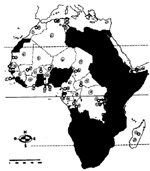|
This series of tasks, the first portion of a unit on African
civilizations (that was developed during the Immersion 101
Institute last summer), presents the geography and basic statistics
of French-speaking Africa. Students are not expected to have
a great deal of previous experience with these countries.
Instead, these tasks help students realize the vitality and
diversity of French-speaking countries in Africa. All instruction,
writing, and student interaction should take place solely
in French. I use it with my seventh- and/or eighth-grade non-immersion
students who have had two to three years of beginning French
study, but it is adaptable to upper level immersion classrooms.
|
L'Afrique Francophone!. |
|
PREPARATION OF ACTIVITIES
These tasks require:
- a blackboard or whiteboard
- a black-and-white, handout-sized map of Africa with
French-speaking countries labeled with numbers and
non-French-speaking countries shaded out (one for
every two students)
- a list of clues that correspond with the map (see
”Task 2’ for details) (one for every two
students)
- sheets of paper and pencils for the students
- computers with Internet access for the students
to work individually or in pairs
- student dictionaries/textbook glossaries
- a table handout for reporting on basic facts about
different countries (see ”Task 3’ for details)
(one for every student)
|
DESCRIPTION OF ACTIVITIES
Task 1 (15-20 minutes):
In this task, the teacher introduces the geographical terms
used in reading and describing maps (”to the north
of,’ ”next to,’ ”near to,’ ”on
the coast of,’ ”between,’ etc.) and the names
of major French-speaking countries in Africa.
To introduce the geographical terms, the teacher draws
an imaginary map on the whiteboard, using countries and
large bodies of water named after the students. Naming the
countries after the students keeps the students engaged
and focused.
The teacher then demonstrates how to describe the countries÷
relative positions, using the ”country1-verb-preposition-country2’
structure (”Pierrepays is to the north of Chantalorie.’).
Students are then called upon to describe the location of
countries relative to one another.
Task 2 (20-25 minutes):
The students work in pairs for this task, with the teacher
circulating to observe and help. Each pair will be given
two papers: a map and a page of clues. Each student should
also have a pencil and blank paper.
Student A takes the clue sheet and a blank sheet, and Student
B takes the map. Student A reads the first clue off the
clue sheet. This clue resembles the following:
"The big country in the north of Africa is Algeria."
Student B then finds Algeria on the unmarked map, labels
it, and says Algeria÷s number to Student A. Student
A then records the number and the country on the blank paper.
The students continue their roles through all the clues,
until every French-speaking country is labeled on the map
and recorded on the blank sheet. Subsequent hints can identify
countries by their physical relationship with previously-identified
countries. When the students complete the exercise, the
teacher collects their papers to be redistributed the next
day.
Task 3 (approximately 120 minutes):
Students each receive a table handout with the columns
labeled ”Country,’ ”Density,’ ”Religions,’
”Languages,’ ”Regime,’ ”Date of
Independence,’ and ”Resources.’ After introducing
the table, the teacher instructs the students to brainstorm
words that fit in these categories. The students first work
in small groups, then share their results while the teacher
records on the whiteboard or overhead.
The students then go to the computer lab, navigating a
web browser to the website.
They could also use a similar site in French which lists
basic facts about African countries. On the table handout,
they research and record the information about the countries
they discovered in Task 2. As each student finishes, they
are paired with another finished student to compare their
answers.
Once the research is done, the students return to the classroom
to work again in small groups. They should compare their
results and find patterns. When the teacher judges that
each group has finished, he/she collects the charts to be
assessed.
Evaluation of Activities
These activities are assessed through a combination of student
self evaluation and teacher observation. Students are directed
in their self evaluation to assess how much, how quickly,
and how well they understood the tasks that they were asked
to perform. They are questioned about their own ability to
work through confusion or frustration as well.
The teacher evaluates the items discussed above, as well
as the student÷s participation in class, their linguistic
and factual accuracy, and their attitude toward the challenges
they faced.
Divergence from Expected Outcomes
No matter how much small-group work and preparatory brainstorming
I use with my students, there are always those students who,
when faced with a page of French clues or an unfamiliar French
website, either ask me repeated questions, find a way around
doing the exercise properly, or (rarely) shut down. I have
learned to expect these reactions, although the small-group
work and preparatory brainstorming do reduce the incidents
of this sort. I have found it most useful to be patient and
available, but not overeager to help.
|

